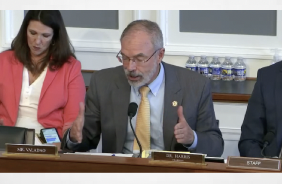October 17th is remembered by many Californians as the anniversary of the Loma Prieta earthquake. Both the San Francisco Bay Bridge and the Cypress Freeway collapsed. Millions around the world witnessed the fires in the Marina District. The Loma Prieta earthquake is now a memory for most Californians. More recent disasters have supplanted these memories. Many present day Californians were not here.
For those involved in California’s cannabis industry two events occurred on the East Coast on the most recent October 17th that will prove to be a tremor equivalent to the Loma Prieta earthquake. Most Californians, even those actively involved in the cannabis industry, will not recognize the significance of these two events. These two events, however, evidence California’s fall from the apex of leadership in the cannabis industry in the United States.
One event occurred in Washington, D.C. The other occurred in New York. The event that occurred in Washington, D.C. was the entry of the DECISIONS in United States Tax Court cases involving Harborside’s federal income tax liabilities for the years 2007-2012. Harborside has put a brave face on its loss Tax Court loss. Harborside has, however, neglected to allow for interest on the tax deficiencies in establishing a tax reserve for projected adjustments to income. Of greater significance, Harborside has failed to properly reflect the consequences of Judge Mark V. Holmes’ opinions in its establishment of reserves for income tax adjustments for the years 2013-2018.
The event that occurred in New York on October 17th is of greater significance for California’s cannabis industry. On October 17th the Governors of New York, Connecticut, New Jersey and Pennsylvania, Governors Cuomo, Lamont, Murphy and Wolf, hosted a summit to establish uniform principles for each state to utilize in order to implement standardized regulations across the Northeast region. Representatives from Rhode Island, Massachusetts and Colorado also attended the summit.
One notable aspect of the reports relating to this summit is the absence of any mention of representatives from California. Who knows the reason? Very likely there were representatives from California. We have no doubt there were attendees who have substantial financial interests in California’s cannabis industry. Rational and intelligent individuals recognize and acknowledge California’s cannabis industry is in a state of chaos. For those interested in the cannabis industry in other jurisdictions, California is instructive for its multiple examples of actions that should not be taken.
Those who follow voting patterns in the United States will immediately recognize that the population of the Northeast, as well as the financial and political clout of the area, exceed the population and clout of California. The financial and political strength of the Northeast alone makes the area a worthy competitor for California. California’s cannabis industry, however, has been rushing headlong toward disaster for several years. Thousands have been lured into the investment of money and effort in California’s cannabis industry like sailors following the song of the Sirens of Greek mythology.
We have described on multiple occasions our opinions regarding the principal reasons California’s cannabis industry continues to become more chaotic. See, [[.
We have suggested from time to time solutions to some of the issues that have surfaced over the past several years in California’s cannabis industry. See, [[.
We realize there are many issues relating to California’s cannabis industry that we do not recognize let alone have any idea how to solve. We know little about cultivation, testing, packaging, etc. We realize California’s cannabis industry faces challenges with respect to a myriad of items. We do not understand many of the granular the issues that face California’s cannabis industry let alone have suggestions for solutions .
We are, however, acutely aware California’s cannabis industry continues to become more chaotic. While we can suggest solutions to only a few of the granular issues facing California’s cannabis industry, we know where solutions to all of the issues facing the industry will be found.
Solutions to big picture issues are found by looking at big picture causes. The causes of all of the problems that confront California’s cannabis industry ultimately flow from a lack of thoughtful and adept leadership. All of the problems relating to California’s cannabis industry flow from the failure of those with the power to influence the course of the industry to competently provide proper leadership and guidance.
Those who were involved in California’s underground cannabis industry were ill-prepared to readily adjust to the new reality of a regulated commercial cannabis industry. Some will survive, but many will not. California’s professional communities, California’s lawyers and accountants, failed to provide proper leadership. Those professionals who leaped into the fray in most instances did so to make money rather than to assist in the transition. The consultants who came forward to provide services to assist with regulatory requirements did so for the same reason. Local political leaders acted for political reasons looking for immediate benefits for their communities through tax revenues and improved economies. Few devoted significant thought to the welfare of California’s cannabis industry as a whole.
The policies that produced Proposition 215 – the War on Drugs and the political misuse of marijuana prohibition – started the ball rolling in California toward adult-use legalization. . Proposition 64 was the product of astute financial and political leadership, but the focus of this leadership was on financial rewards for the backers of the proposition. For the financial backers of Proposition 64, Californians are merely consumers.
The Legislature cobbled together the Medical and Adult Use Cannabis Regulation and Safety Act (“MAUCRSA”) based on Proposition 64. The primary guiding force for the decisions of every legislator was political – act to please as many as possible while offending as few as possible. Elected officials temper all evaluations of what is best for California with their views to the impacts of their actions on the next election. The Legislature ignored several key aspects of the report of the Blue Ribbon Commission on cannabis because it was politically expedient to do so.
What about the money and effort expended to administer MAUCRSA? The administrative structure California established for the regulation of the cannabis industry illustrates many of the inherent problems of governmental agencies. Governmental agencies are process-driven as distinguished from product-driven. The administrative agencies tasked with the regulation of California’s cannabis industry promptly set out to establish effective administrative organizations to regulate every aspect of the movement of cannabis from cultivator to consumer in a two-tier regulatory system.
California’s effort to create administrative agencies was a great success. Systems and processes were established for the comprehensive and detailed regulation of every aspect of California’s cannabis industry. At least two new administrative departments of significant size were established. Two others were significantly expanded. More than a dozen other California agencies were seriously expanded. California’s effort to establish administrative agencies to regulate the cannabis industry was so successful that a majority of those already involved in the industry gave up or decided to remain in the underground industry. California’s cannabis regulatory agencies have successfully caused the expansion of both the legal and the underground cannabis industries.
California’s leadership failed to understand that the goal was the transition an underground commercial industry into a regulated commercial industry. This failure was wholly a failure of leadership – political leadership; leadership from within California’s cannabis industry; leadership from the professions; leadership from local government; and leadership from law enforcement. It is our opinion that the single most significant failure of leadership is found in the leadership of the administrative agencies tasked with implementing the transition of an underground commercial industry into a regulated commercial industry.
The leaders of California’s administrative agencies tasked with the regulation of its cannabis industry concentrated on building administrative empires instead of making it as easy as possible for those involved in California’s cannabis industry to transition into a regulated commercial industry.

















